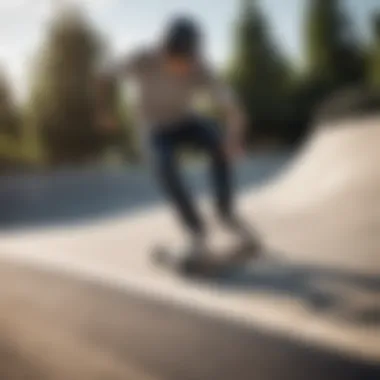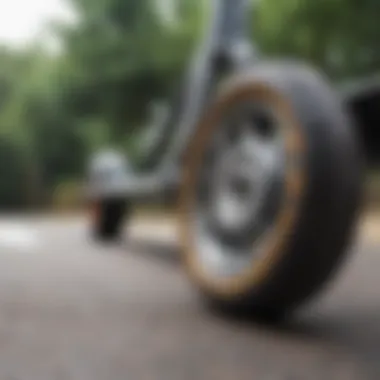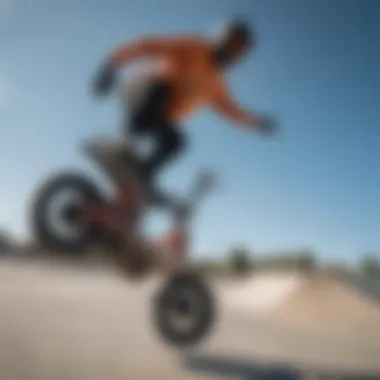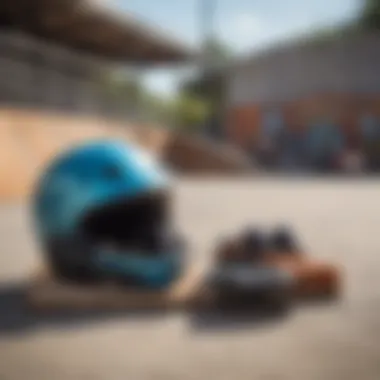Choosing the Best Skatepark Scooters for Riders


Intro
When it comes to skatepark riding, scooters are swiftly gaining traction, attracting enthusiasts of all skill levels. These versatile machines blend the thrill of skateboarding with the ease of maneuverability, making them ideal for performing tricks and navigating challenging terrains. Choosing the right scooter is not just about aesthetics; it's about understanding what makes a scooter tick in a skatepark setting. From the design elements to the performance features, there’s a lot to consider.
Skateboarding Techniques
Skatepark scootering isn’t simply about riding around; it's an art. Mastering various techniques can transform the experience into something exhilarating.
Essential Tricks for Beginners
For those just getting their feet wet, it’s vital to start with the basics before soaring into the more advanced stunts. Here are a few beginner-friendly tricks:
- The Bunny Hop: Elevate both the front and rear wheels simultaneously, a foundational move for further tricks.
- The Tail Whip: Kick the scooter deck around while airborne, landing back on it smoothly.
- Manual: Balance on the back wheel without putting the front wheel down. This helps in controlling speed and precision.
Developing a knack for these tricks lays a strong foundation to grow upon.
Advanced Maneuvers for Seasoned Skaters
Once confidence has been built, seasoned riders can explore intricate maneuvers. Some popular advanced tricks include:
- Barspin: Rotate the handlebars in a circular motion while in mid-air.
- Flair: Execute a backflip with a twist, landing cleanly as you emerge from the ramp.
- 540 Spin: Rotate a full one and a half times in the air, requiring both skill and guts.
Mastering these techniques not only builds confidence but fosters a sense of community as riders share tips and tricks within skateparks.
Skate Culture
Scootering has woven itself into the vibrant tapestry of skate culture, shaping unique identities and experiences.
The Evolution of Skateboarding Styles
Historically, the styles have evolved drastically. Early skateboards were rudimentary, primarily focusing on transport. Today’s scooters reflect a commitment to design, incorporating lightweight materials that can withstand the rigors of park tricks. Each style has its own flair, appealing to different rider personalities.
Community Engagement and Local Events
Part of the thrill of skateboarding culture lies in community interaction. Many skateparks host events that gather riders, fostering friendly competition as well as camaraderie. Participating in these events is a great way to learn from others while networking within the community.
"The best way to learn is from each other, and the skatepark is a hub for that shared knowledge and creativity."
As one dives deeper into the lifestyle, the connection with fellow skaters can lead to not just friendships but mentorships that elevate skills and experiences even further. From local meet-ups to international competitions, skate culture continues to flourish.
Epilogue
In the rapidly evolving world of scootering, understanding the techniques and the culture is indispensable for both novices and advanced users. Choosing the right scooter should align with one's aspirations, whether it’s mastering basic tricks or hitting the big leagues. With proper guidance and practice, every rider can find their niche in the vibrant skatepark scene, enriching their journey with knowledge, skill, and community engagement.
Understanding Skatepark Environments
Understanding the complexities of skatepark environments is crucial for anyone looking to choose the right scooter for their needs. Skateparks come with their own unique blend of features that directly influence the performance and usability of scooters. Riders must navigate various terrains, and being familiar with these aspects can vastly improve their experience.
The Architecture of a Skatepark
Each skatepark has its own architectural style, often combining different elements designed to challenge and excite skaters. From half-pipes to quarter pipes, transitions, and ledges, the architecture sets the stage for the riding experience.
- Half-Pipes: These structures allow for high-flying tricks and smooth jumps. A good scooter can execute air tricks on these features with ease.
- Ledges and Rails: Perfect for grinding, but they demand scooters that are flexible and rigid enough to handle difficult landings.
- Bowls: These banked structures allow riders to carve in a unique manner. A scooter designed for agility can make all the difference.
When choosing a scooter, consider how these elements align with your own riding style. Is your approach aggressive, or do you prefer a smoother, more flowing ride?
Common Obstacles and Features
Navigating a skatepark means facing a variety of obstacles and features that test a rider's skills. A proper understanding of these can inform what kind of scooter might be best.
Common skatepark features include:
- Stairs: They present both a challenge and a thrill as riders descend or ascend. A lightweight scooter is advantageous here.
- Banked Turns: These allow riders to maintain momentum and speed. If you enjoy cruising, look for scooters that enhance stability at higher speeds.
- Flat Rails: Grinding is a fundamental aspect of skateboarding culture, especially on smooth, flat rails that provide a long runway for tricks.


"When you step into a skatepark, understanding its features can make or break your session. You want your scooter to feel like an extension of yourself, ready to tackle whatever obstacle comes your way."
By familiarizing yourself with the architecture and features of a skatepark, you can have more informed discussions about scooter options, ensuring your choice ultimately enhances your riding experience instead of hindering it. With these insights, the path towards selecting a scooter tailored for skatepark use becomes much clearer.
Key Attributes of Good Scooters
When it comes to skatepark riding, selecting the right scooter is not just a matter of preference; it can significantly impact your overall experience and performance. Understanding the crucial attributes of quality scooters helps riders, both novice and experienced, navigate the vast array of choices available in the market. This section will delve into fundamental aspects such as frame durability, wheels and bearings, deck size and shape, and handlebar height and adjustability. Each of these elements plays a pivotal role in ensuring that your scooter meets the demands of demanding skatepark environments.
Frame Durability
Frame durability is arguably one of the most important attributes to consider when selecting a scooter. The frame acts as the backbone of the scooter, bearing the weight and absorbing shocks from jumps and tricks. Materials like aluminum and steel are often used in high-quality scooters, where aluminum provides lightweight benefits, while steel offers ruggedness.
- A durable frame withstands the rigors of skatepark riding.
- It minimizes the risk of breakage or bending during aggressive maneuvers.
Considerations for durability include:
- Material type: which type meets your needs?
- Design elements: how does the frame’s geometry affect your balance?
Investing in a well-constructed frame will not only enhance your riding experience but will also reduce long-term costs linked with repairs or replacements.
Wheels and Bearings
Scooter wheels and bearings are essential components that influence speed, agility, and overall ride quality. High-quality wheels ensure smooth transitions and controls, important for navigating the various features found in skateparks.
Key points in wheels and bearings:
- Wheel diameter: larger wheels roll over terrain better, while smaller wheels offer more maneuverability.
- Durometer (hardness): harder wheels are faster but provide less grip, while softer wheels offer better traction but may slow you down.
Bearing quality is just as crucial. Precision bearings provide less friction and higher speeds, making them ideal for those who want to push their limits. A good tip is to look for bearings that have been rated by the ABEC scale, where higher ratings usually correlate with faster, smoother ride experiences.
Deck Size and Shape
The deck of a scooter serves as the platform for your feet, and its size and shape play an important role in your stability and control while riding.
- Larger decks offer more foot space, which can be beneficial for beginners learning tricks.
- Narrower decks are better for advanced riders who perform intricate maneuvers, as they allow for greater agility.
The shape of the deck can also influence performance. Some decks come with a concave design, which helps with foot grip during tricks. A flat deck, on the other hand, may provide a more stable landing surface. When evaluating options, consider what works best for your riding style and skill level.
Handlebar Height and Adjustability
Handlebar height is crucial in achieving a comfortable posture while riding. A properly adjusted handlebar not only enhances control but also affects overall performance and comfort during long sessions at a skatepark.
- Adjustable handlebars can grow with a rider as they develop skills, making them a great investment for younger riders.
- Your height will determine how high or low you should set your bars. As a general rule, the handlebars should reach around waist height for optimal control.
Remember that a comfortable grip will improve your handling and stability during rides. Evaluate how handlebars feel in different stances to find what’s best for you.
"Choosing the right attributes can turn your sessions from ordinary to exceptional. A scooter that feels right will empower you to push your limits."
In summary, the key attributes of good scooters—frame durability, wheels and bearings, deck size and shape, and handlebar height and adjustability—are foundational in crafting a superior riding experience in skateparks. Riders should consider these elements thoughtfully to find the perfect match for their skills and styles.
Safety Considerations in Skateparks
Skateparks are dynamic spaces where excitement and risk often go hand in hand. Understanding safety considerations in these areas is not just a matter of personal choice; it’s pivotal for protecting the well-being of all riders involved. Being in an environment filled with ramps, rails, and various obstacles, it requires skaters and scooter riders to adopt specific practices aimed at minimizing injury and fostering a sense of community.
First, let’s get clear on the basics: the thrill of skating shouldn’t overshadow the need for safety. With the right precautions, riders can fully enjoy their time while also ensuring they minimize the chances of mishaps. From protective gear to following skatepark etiquette, all these elements can make a real difference in maintaining a safe and enjoyable atmosphere.
"Safety isn’t just an afterthought; it’s part of the ride."
Protective Gear Essentials
When it comes to protective gear, some might view it as an unnecessary add-on, but in reality, it can mean the difference between a minor tumble and a serious injury. Here’s a closer look at some essentials:
- Helmets: The most crucial item for any rider. A quality helmet can protect your brain from potential damage during falls, making it a non-negotiable piece of equipment. Make sure it’s fitted properly too.
- Knee and Elbow Pads: These provide cushioning for those inevitable falls. They can absorb impact and reduce the severity of scrapes or bruises.
- Wrist Guards: Unlike common perception, breaking a fall often involves extending the arms. Wrist guards help in preventing fractures or sprains.
Investing in protected gear is like putting a seat belt on; it’s better to have it and not need it than to need it and not have it.


Understanding Skatepark Etiquette
Etiquette in skateparks is often overlooked but plays a huge role in maintaining safety and harmony among riders. It’s not just about following rules; it’s about respecting one another. Good manners can prevent a lot of accidents and ensure everyone enjoys their time. Here are some key points to consider:
- Watch Your Surroundings: Always be aware of other riders around you. Before launching off a ramp or attempting a trick, check that the area is clear.
- Take Turns: If multiple riders are waiting to use the same feature, try to communicate and take turns. This courtesy can prevent collisions and create a friendly atmosphere.
- Respect Skill Levels: Not everyone is at the same level, and that’s fine. Encourage less experienced riders instead of getting impatient or aggressive. A little kindness goes a long way in building community and reducing anxiety amongst newbies.
In short, a mindful approach to skatepark etiquette can enhance safety, making the experience enjoyable for everyone. Knowing how to navigate these shared spaces ensures that fun doesn’t come at the expense of safety, paving the way for a positive skatepark culture.
By emphasizing safety considerations such as protective gear and etiquette, riders can enhance their experience while reducing risks. The skatepark vibe is all about camaraderie and pushing limits, but let’s not forget to keep it safe.
Top Scooter Models for Skateparks
When it comes to enjoying the thrills of a skatepark, the choice of scooter can make all the difference. Various models cater distinctly to riders' preferences and the challenges posed by the parks. Selecting the right scooter not only makes the riding experience more enjoyable but also adds a layer of safety and performance. A scooter that excels in features and design often enhances control, agility, and durability, thereby allowing riders to push their limits.
Analysis of Popular Brands
There are several brands that stand out in the scooter market when we talk about skatepark usage. Each brand brings unique strengths to the table, appealing to a spectrum of riders from beginners to seasoned pros. Manufacturers such as Razor, Envy, and Fuzion have carved out niches by focusing on quality, innovation, and performance.
- Razor has long been recognized for providing scooters that blend affordability with reliability. Their models often feature sturdy builds, perfect for those new to skating.
- Envy Scooters are known for their attention to detail and aesthetic appeal. They cater to the intermediate and advanced markets, offering scooters with lightweight, yet strong materials.
- Fuzion hits the sweet spot for both price and performance. Ideal for up-and-coming riders, their models are designed to withstand rigorous skatepark conditions while remaining easy to maneuver.
These brands create a diverse field of options, enhancing the likelihood that every skater can find a scooter that resonates with their riding style.
Performance Review of Leading Models
In examining popular scooter models, performance is paramount. Each model's design can significantly impact the way a rider interacts with the skatepark, whether they’re nailing tricks or cruising down ramps.
- Razor Pro X: This model is appreciated for its solid aluminum frame and sturdy wheels. Riders often comment on its balance and stability, especially when attempting jumps.
- Envy Prodigy: Highly favored among enthusiasts, this scooter excels in both durability and style. The reinforced deck allows for higher jumps and is popular in competitive circles.
- Fuzion Z300: Featuring high rebound wheels, this model offers a smooth ride, even on the roughest surfaces of a skatepark. Casters and bearings are engineered to reduce friction, enhancing the rider's speed and control.
"Having the right scooter is like having the right gear in any sport. It just paves the way for a smooth ride."
Many skaters will share their experiences with specific models, offering first-hand insights which are invaluable for someone on the fence about what to purchase. Individual preferences come into play too; some riders may prefer a lighter scooter for agility, while others might choose a heavier model for stability during tricks.
Understanding how these scooters perform in real-world settings is critical for making an informed decision. Riders looking for optimal performance should seek out reviews and gather feedback from both casual users and competitive skaters.
User Preferences and Experiences
User preferences and experiences play a crucial role in the world of skateparks, where scooters become an extension of a rider's identity and style. The selection of a scooter is not merely a mechanical choice; it's often influenced by individual needs, comfort, and riding aspirations. Recognizing these personal elements can significantly enhance one's skating journey. When users find a scooter that resonates with their style and skill level, they tend to ride more confidently and creatively.
Feedback from Casual Riders
Casual riders—the backbone of any skatepark's community—often bring a fresh perspective to scooter choices. Their feedback highlights the importance of versatility and ease of use. Many emphasize the desire for a scooter that is lightweight, making it easier to perform tricks without causing undue fatigue. This factor becomes paramount, especially for those who may not skate daily.
Some casual riders recommend focusing on the deck size. A wider deck can offer more room for foot placement, which promotes stability when trying out new tricks. They often share experiences like:
- A light frame that aids in quick spins.
- Wheels that glide smoothly over various surfaces without excessive wear and tear.
- A design that feels balanced, instilling confidence during larger jumps.
Moreover, informal feedback from friends or in community forums can guide newbies in making informed choices. Positive conversations about specific brands often create buzz, leading others to explore models like the Fuzion Z300 or Root Industries Air. It’s essential to capture these insights, as they reflect the practical demands casual riders have when choosing scooters for fun and leisure.
Insights from Competitive Skaters
In stark contrast to casual riders, competitive skaters live and breathe adrenaline, pushing their limits at every opportunity. Their approach to scooter selection is rooted in performance and precision. Feedback from this demographic highlights several vital points regarding the best scooters for skateparks.
Competitive riders often seek scooters that can withstand high-impact tricks. They discuss the necessity for durable materials, such as aircraft-grade aluminum, and speak highly of scooters like the Lucky Prospect and Envy Prodigy for their robust construction.
Considerations from competitive skaters include:
- Performance Response: The sensitivity of the scooter during a trick can impact whether a rider sticks a landing or takes a spill.
- Customization Options: Many competitive riders appreciate components that can be tailored to their preferences, whether that's adjusting the handlebar height or swapping wheels for specific grip.
- Weight and Agility: Lower weight scooters allow for quicker transitions between tricks, a significant edge in competitive settings.
"The right scooter can make a world of difference in my performance. When everything feels just right, I can focus entirely on executing my tricks perfectly."
– A competitive skater's insight into performance and its impact on success.
In summary, understanding the perspectives of both casual and competitive skaters provides a comprehensive view of user preferences. From casual enjoyers looking to stay light on their feet to competitive riders demanding peak performance, these experiences inform the wider community about what makes a great scooter for the skateboard environment.
Maintenance and Care for Optimal Performance


Maintenance and care for scooters are crucial if one wishes to excel in skatepark scenarios. It ain't just about kicking back and enjoying the ride; giving your scooter regular TLC ensures it performs at its best and keeps you safe. Besides, nobody wants to be that person who’s stuck in the middle of a trick because their gear failed. When you give attention to the little details, it often leads to big gains in performance.
You see, scootering is not only a sport; it's an experience, an art. Just like musicians take care of their instruments, riders should look after their scooters. More care means more fun on the park’s ramps and rails. Let's dive into the nuts and bolts of maintaining and caring for your trusty two-wheeler.
Routine Checks and Repairs
Regular checks should become part of your daily routine if you frequently hit the skatepark. Here’s some advice that can keep your scooter in tip-top shape:
- Inspect the wheels: Check for any cracks or wear. The last thing you need is a wheel giving out during a big jump. You want those wheels to spin freely, so look for any debris stuck in the bearings.
- Look at the brakes: Ensure they’re working properly. If the brakes are squishy or make weird noises, it might be time to tighten or replace them. A functional brake might just save you from a nasty spill.
- Check the deck for chips: A chipped deck compromises performance. If your deck shows signs of wear, consider sanding it down or applying grip tape in areas where it has peeled off.
- Tighten everything up: Regularly check screws and bolts. Over time, a loose handlebar or deck can make a world of difference in your ride quality and safety.
Keeping a checklist for these checks might save on unexpected repair costs in the long run. So every time you head to the park, make sure to allot a few minutes to give your scooter a quick once-over.
Long-term Care Strategies
Next up, let’s discuss strategies for long-term care if you want your scooter to last beyond a few seasons.
- Store it properly: Every scooter needs a home. When you're done using it, keep it in a cool, dry place. Don’t leave it outside—it’s not a garden gnome. Moisture and extreme temperatures can cause significant wear on components.
- Clean it regularly: After a session in the skatepark, take a moment to wipe down your scooter. Dust, mud, or water can accumulate and lead to bigger problems down the line. A simple mixture of water and mild soap does wonders.
- Lubricate moving parts: Don’t let friction slow you down. Apply lubricant to the bearings and any movable parts at regular intervals. This ensures a smoother ride and enhances performance, making those jumps feel easier.
- Invest in quality upgrades: If you find yourself enjoying scootering, investing in better parts might be worthwhile. Whether it’s upgrading to lighter wheels or a fancier deck, high-quality parts will elevate your overall experience.
As the saying goes, "An ounce of prevention is worth a pound of cure." That truly applies here. Investing time and effort into your scooter’s upkeep will pay dividends later.
By maintaining and caring for your scooter, you become not only a better rider but also contribute to the longevity of your gear. It’s all about respecting the ride and ensuring optimal performance while enjoying your time in the skatepark.
Emerging Trends in Scooter Design
The world of scooters, particularly those made for skateparks, is undergoing a noticeable transformation. Staying relevant in today’s fast-paced environment requires manufacturers to constantly adapt and innovate. Emerging trends in scooter design not only enhance performance but also cater to the unique demands of riders at skateparks. Here, we dive into two primary areas: innovative material use and technological enhancements.
Innovative Material Use
When you think of a scooter, the image that pops up is often one made of metal or plastic. But, nowadays, designers are getting creative. There’s a marked shift towards the utilization of advanced materials that offer both lightweight properties and durability. For instance, carbon fiber is making waves for its incredible strength-to-weight ratio, allowing scooters to be sturdier without the added heft. Likewise, aluminum alloys, specifically those in the 7000 series, are frequently employed for their blend of toughness and lightweight nature.
The benefits of these materials are quite significant:
- Increased Performance: Lighter scooters enable riders to perform tricks with greater ease and speed.
- Enhanced Longevity: Durable materials mean fewer repairs and replacements, making them more cost-effective in the long run.
- Safety Boost: Better materials can provide improved stability during high-impact tricks, reducing the risk of accidents.
Adopting these innovative materials isn’t just a trend; it’s a necessary evolution driven by rider needs. By making the scooter more robust yet lightweight, manufacturers help skaters truly push the limits of what's possible.
Technological Enhancements
The realm of scooter design isn’t just about the physical materials; technology is also playing a pivotal role. More models incorporate features that were once exclusive to other sports or forms of transport. For example, the integration of smart sensors in scooters is gaining traction. These sensors can track performance metrics, which can be essential for those looking to improve their skills.
In addition, there’s an increase in scooters featuring shock-absorbing systems. These systems minimize the impact felt by riders, especially during jumps and stunts. This tech allows for a smoother ride and significantly less strain on the rider’s body.
Other technological elements include:
- Adjustable Handlebars: Allowing riders to fine-tune their setup according to their height or preference.
- LED Lighting Features: Not just for aesthetics, they enhance visibility, offering safety during evening rides.
- Folding Mechanisms: Effective for portability, enabling easy transport of the scooter to and from the skatepark.
Emerging trends in scooter design signify that the industry is not just resting on its laurels. As riders demand lighter, safer, and more customizable options, manufacturers are answering the call with new designs, materials, and technologies that meet these evolving needs. It's an exciting time to be part of the scooter community, where advancements promise to enrich the experience of all who ride.
Final Thoughts on Selecting a Scooter
Choosing the right scooter for skatepark use is a decision that goes beyond just aesthetics; it involves a solid understanding of personal preferences, budget considerations, and the demands of the skatepark itself. As you navigate through countless options available today, it becomes increasingly clear how essential it is to weigh these factors carefully. Your ride can significantly influence your skating experience, from how it handles jumps and ramps to how comfortable you feel in your own skin while riding.
The importance of evaluating what works for you personally can't be overstated. Every skater has their unique style and skill level, which will affect how well they connect with their scooter. While some riders prioritize agility and speed for performing tricks, others may seek out stability and strength for those big landings. Hence, taking the time to understand your own needs before making a purchase can make all the difference.
Weighing Personal Preferences
When it comes down to it, personal preferences play a monumental role in selecting a scooter. Skaters need to consider various elements such as weight, size, and material. For example, a lighter scooter might be easier for some to maneuver, particularly in performing tricks, while a sturdier model might offer more durability under the wear and tear of skatepark jumps and challenges. Here are some essential points to keep in mind:
- Riding Style: Understand if you are more inclined towards ramps, street-style riding, or performing tricks. Each style may demand a specific type of scooter.
- Size and Fit: Ensure that the scooter is the right size for you. A scooter that's too big or small could compromise your comfort.
- Aesthetic Appeal: Sometimes, it’s okay to choose a scooter that speaks to your sense of style. An appealing design can enhance your confidence and presence in the park.
As you weigh these preferences, give yourself room to experiment with different options. What might seem ideal on paper may not resonate in practice. Don’t hesitate to check reviews from fellow skaters or even test ride scooters if possible.
Budgeting for Quality
Allocating a budget can seem like a daunting task, but it's a crucial step in the scooter selection process. Investing in quality pays off significantly in terms of performance and durability. While it might be tempting to grab a cheap scooter just to get started, consider the potential drawbacks such as frequent repairs and compromised experiences. Here are a few budget considerations to keep in mind:
- Price Range: Recognize that good quality scooters typically range from moderately priced to high-end models. Identify where you stand on that spectrum based on usage.
- Longevity vs Initial Cost: A more expensive scooter may have superior materials, thereby lasting longer and requiring fewer replacements.
- Resale Value: Some brands hold their value better than others. If you plan on upgrading, think about how much you could recuperate if you choose a well-regarded brand.
Ultimately, a well-thought-out budget allows you to zero in on scooters that align with your riding style while ensuring that you don’t overspend or settle for an inferior product. Remember, while cost is important, your riding experience should be the primary goal.
Selecting a scooter is not just about choosing an item; it's about investing in your experience and passion for skating. Choose wisely.















